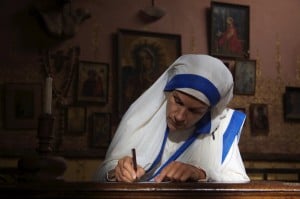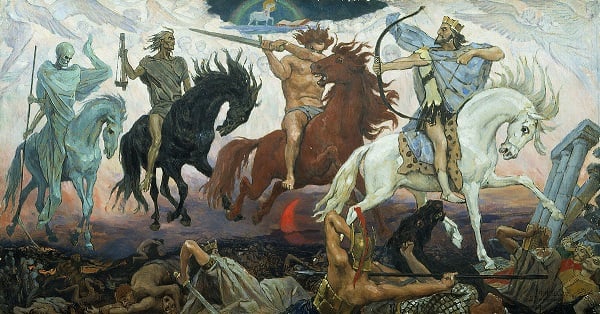This morning I was flummoxed to read in The Tablet a list of twelve women who supposedly “helped shape Christianity.” Numbered among this august group, according to writer Peter Stanford, are a prostitute, an excommunicated ex-nun, and an imaginary heroine who never even existed. Where on the list, I wondered, is St. Catherine of Siena, who had the political boldness to “speak truth to power” and who counseled Pope Gregory XI to return to Rome from Avignon and resume leadership and reform of the Church? Near the top of my list would be Blessed Teresa of Calcutta, who by her example showed us all how to love the most humble of God’s beloved creatures? And then there’s St. Therese of Lisieux, who showed us that the path to sainthood is open to all of us? But no. The Tablet‘s list of political activists and little-knowns includes: 1. and 2. “THE HOLY MARYS” (lumped together because Stanford thinks they have equal stature):
By this Stanford means
1. MARY, THE MOTHER OF GOD, the spotless Virgin who carried Christ in her womb; and
2. MARY MAGDALENE, the repentant sinner. (Not to take anything away from Magdalene’s friendship with Our Lord; but on a par with his Mother? Nah.)
In fact, Stanford is so adamant about Mary Magdalene’s prominence in the story of the Church that he gives her top billing. And he has chosen the narrative which claims that she is a “fallen woman”, a repentant prostitute.
3. THEODORA EPISCOPA. To which I say: “Who?”
The Tablet writer is obviously a proponent of women’s ordination, and the point of his article was to herald the vote this week in favor of female bishops in the Episcopal Church. That he had to go back to the fifth century to dig out this unknown woman, one of four figures depicted in a mosaic in the minor Basilica of Saint Prassede, suggests that it’s not as easy as one might hope to find historical support for the ordination of women.
In fact, most Church historians find Stanford’s interpretation of the mosaic’s title to be weak. Catholics and Orthodox believe that a more accurate translation of “Episcopa Theodora” is “bishop’s wife”; her white coif, by this definition, represents social modesty, and were she truly a bishop as Stanford wishes, she would be wearing a mitre or zuchetto. History does tell us that Theodora is the mother of Pope Paschal–but has she played a great role in the development of the Church? Well, you’ve never heard of her, right?
4. HILDA OF WHITBY. And again I ask, “Who?”
Hilda was an Anglican–and that likely factored into Stanford’s selection of the abbess for his “Best Of” list of women. She was the founding abbess of Whitby Abbey, then known as Streoneshalh.
Actually, though, not much is known of her life. All of what we DO know with assurance comes from the writings of St. Bede, who describes her as a talented administrator and teacher, and a woman of great energy. Her abbey was destroyed by Danish conquerors in 867.
5. POPE JOAN!!!! The fantasy pope, darling of the women’s ordination movement.
And here I definitively part ways with Stanford: Pope Joan did not exist.
Joan is a mythical female pope who supposedly ruled the Catholic Church sometime during the Middle Ages. According to legend, she disguised her gender but, while riding through Rome on a horse, she allegedly gave birth–thus exposing herself as a woman. Most stories go on to say that Pope Joan died shortly thereafter, either at the hands of an angry crowd or because of some disease. After her death, say her true believers, her memory was shunned. Here is the story as Peter Stanford tells it:
Joan is said to have been a bright, young German woman, who disguised herself as a monk to continue her education, but was so successful that she had attracted the patronage of Pope Leo IV, and was elected his successor as Pope John. Her true gender was discovered only when she gave birth in the street in Rome during a papal procession. The accounts variously describe her as being stoned to death, along with her baby, or tied to the legs of a horse and dragged through the street until dead.
It’s worth noting that there is no confusion about which Pope served the Church in which years. The fact of “Apostolic Succession” means that we know exactly who was pope, and in which order. If you question that, take a few minutes now–go ahead, do it now!–and look up the listing of popes on Catholic-Hierarchy.org.
If you are still skeptical, a good place to get more information might be this article from Catholic apologist Patrick Madrid.
6. HILDEGARD OF BINGEN. Well, okay. Hildegard is, at least, a real person. Oh, by the way, I wrote in August 2011 that Hildegard of Bingen was one of six women on track to be named a “Doctor of the Church”–a title conferred on holy people whose “eminens doctrina” (eminent learning) qualifies them for doctrinal leadership within the Church. That did, in fact, happen in 2012. Stanford seems to believe that whereas women were once well regarded by people of faith, they have been forced to take a back seat to men in current times. He writes:
Freed of the control of men, this all-female environment proved to be a hothouse for encouraging excellence in all areas of work.
Perhaps the news that Hildegard has joined three other female Doctors of the Church–St. Teresa of Avila, St. Catherine of Siena and St. Therese of Lisieux–to be teachers and role models for the entire Church will give him some assurance that women are now, as in the past, highly regarded in the Catholic Church. Hildegard wrote poetry, theology and medical and botanical tracts. She was a composer and musician. Here, if you’ve got a few minutes, is a compilation of her “Spiritus Sanctus”: 7. ELIZABETH OF HUNGARY.
I actually like Stanford’s description of saintly Elizabeth, daughter of King Alexander II of Hungary. He writes:
One of the very few female saints to have been married and had children, Elizabeth was a king’s daughter who was betrothed at the age of four. As an adult, she began doing charitable works, inspired by her faith. On the death of her husband, when she was 20, she resisted all attempts to force her to remarry, and became a lay Franciscan, founding a hospital for the poor and sick. So devout was she that she was reputed on occasion to share her bed with a female leper to make reparation for her own sins of pride.
St. Elizabeth is the patron saint of bakers, countesses, death of children, falsely accused, the homeless, nursing services, tertiaries, widows, and young brides. Her symbols are alms, flowers, bread, the poor, and a pitcher.
8. MARY WARD.
Here, Stanford appears to believe that Mary Ward was influential in spite of the “big bad Church”, which did all in their power to hold her back. This much is true: Her religious order was suppressed by Pope Pius V because the current laws required solemn vows and strict papal enclosure as a part of women’s religious life. However, her work was well regarded within the Church; Popes Paul V, Gregory XV and Urban VIII had shown her great kindness and spoken in praise of her work. In 1629, she pleaded her cause in person before the congregation of cardinals appointed by Pope Urban to examine the situation. The order was suppressed the following year; but her work continued unabated, and only a few years later the Rule of her institute was granted the official approval she sought.
Mary Ward is held in high esteem by both Catholics and Anglicans–a great meeting point for people of faith.
9. ST. THERESE OF LISIEUX.
Here she is! Known as “the Little Flower,” St. Therese promised that she would spend her Heaven doing good here on earth. Stanford wrote of her:
“Great deeds are forbidden me,” she wrote. “The only way I can prove my love is by scattering flowers, and these flowers are every little sacrifice, every glance and word, and the doing of the least actions for love.” She suffered ill health throughout her life, which she bore gladly, dying at the age of 24. After her death, her spiritual journal, The Story of a Soul became a bestseller.
Here’s a frustration: Stanford in a word belittles the Catholic devotion to relics, calling the pious practice of praying before her relics (bits of her bones) “a medieval spectacle.” 10. BLESSED TERESA OF CALCUTTA. Yes, glad to see her on the list. Mother Teresa, who died in 1997, is on a “fast track” to sainthood because her heroic holiness is just so obvious to all. Mother Teresa experienced a call to serve the poorest of the poor–“people who have become a burden to society and are shunned by everyone.” Her Missionaries of Charity in their simple blue and white habits are now active in 130 countries, with more than 4,000 sisters living the simple lifestyle she espoused. She was awarded the Nobel Peace Prize in 1979. Unfortunately, Stanford can’t resist the opportunity to criticize this holy woman, citing the unfortunate and discredited book by the late Christopher Hitchens, “The Missionary Position”.
Wherefore, in order that all doubt may be removed regarding a matter of great importance, a matter which pertains to the Church’s divine constitution itself, in virtue of my ministry of confirming the brethren (cf. Lk 22:32) I declare that the Church has no authority whatsoever to confer priestly ordination on women and that this judgment is to be definitively held by all the Church’s faithful.











